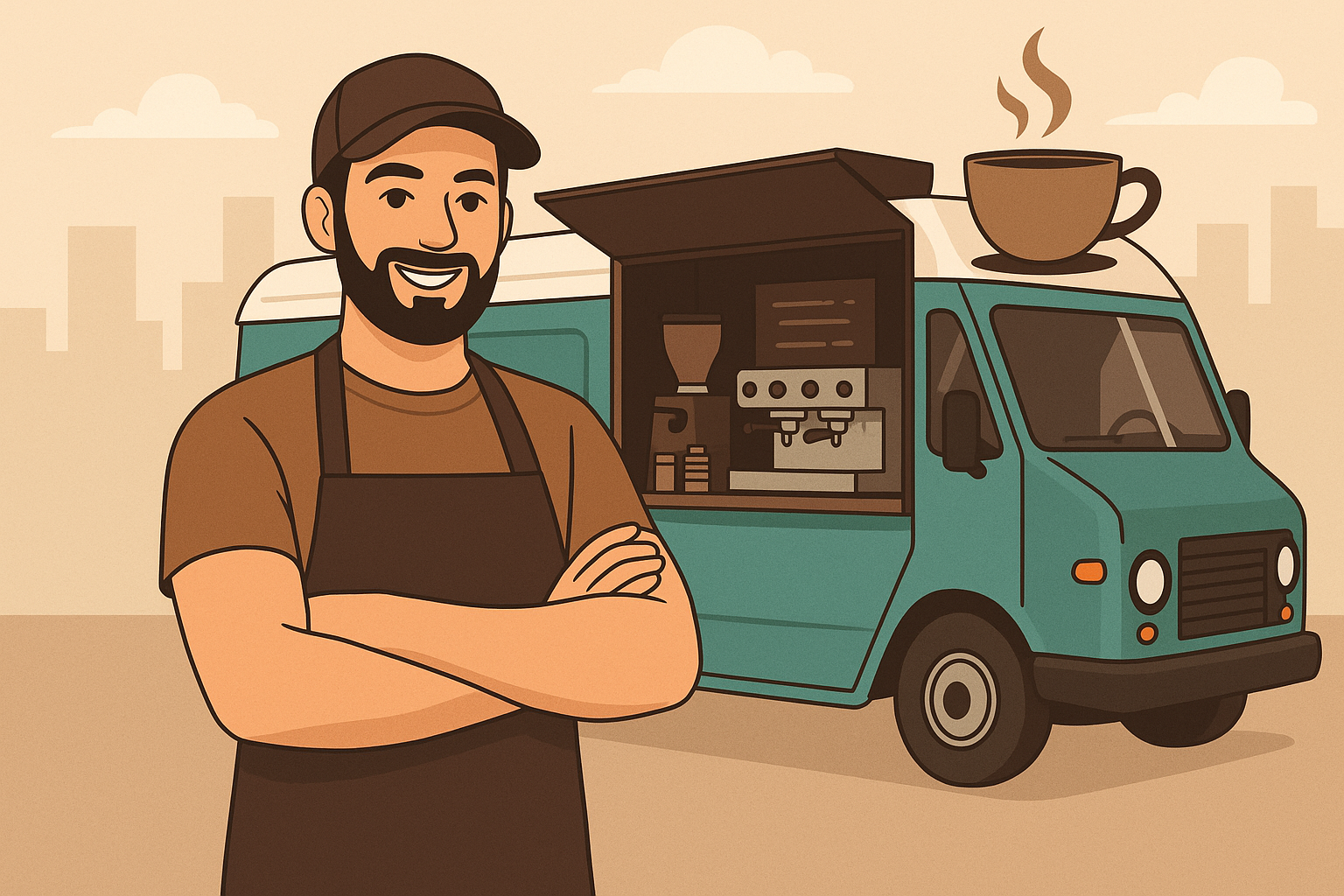For many baristas, the dream goes beyond making drinks behind someone else’s bar. It’s about building something of your own — a space where you control the vibe, the menu, and the mission. But opening a full-scale café can be expensive and risky.
That’s where the coffee truck comes in.
A coffee truck offers freedom, mobility, lower startup costs, and direct connection with your community. Whether you want to serve espresso downtown, hit local markets, or park outside office buildings, it’s a business model that’s flexible, creative, and full of opportunity.
This guide will walk you through everything you need to know to launch your coffee truck — from planning and permits to equipment and marketing — so you can take your first step toward barista entrepreneurship.
Why a Coffee Truck Might Be Right for You
Before diving into logistics, let’s talk about why coffee trucks are so appealing.
Benefits include:
- Lower overhead than a brick-and-mortar café
- Mobility — you can go where the customers are
- Faster launch — no long-term leases or construction
- Built-in marketing — people love food trucks
- Scalable growth — one truck can become two
If you’re a barista with business instincts, a creative menu, and a strong work ethic, a coffee truck could be your perfect launchpad.
Step 1: Define Your Vision and Brand
Before buying equipment or scouting locations, take time to define your concept.
Ask yourself:
- What type of coffee experience do I want to offer?
- Will I focus on espresso drinks, pour-overs, cold brew, or all of the above?
- Will I have pastries or food?
- Who is my ideal customer? Office workers? Festival-goers? Students?
Your brand identity should reflect your personality and mission. Think of a name, logo, color palette, and vibe that will stand out — especially in crowded food truck markets.
Pro tip: Keep your brand flexible enough to grow with you. Today it’s a truck — tomorrow, maybe a full café.
Step 2: Write a Business Plan
Even if you’re a solo operator, a solid business plan helps you stay focused, attract investors, and avoid costly mistakes.
Your plan should include:
- Business summary: Who you are and what your truck is about
- Market research: Your target audience and competitors
- Menu and pricing: Keep it simple, profitable, and fast to execute
- Startup costs: Vehicle, equipment, licensing, branding
- Revenue projections: Expected income vs expenses
- Marketing strategy: How you’ll attract and retain customers
- Growth goals: Events? Additional trucks? Brick-and-mortar later?
Having a written plan shows that you’re serious — and gives you a roadmap to follow when challenges come.
Step 3: Understand Legal and Licensing Requirements
Starting a coffee truck means dealing with permits and regulations. These vary by country, state, and even city — so research your local requirements early.
You’ll likely need:
- Business license
- Food service permit
- Mobile vending license
- Health department inspection
- Parking or vending permits
- Insurance (vehicle, liability, product)
Some cities have strict rules about where and when trucks can operate. Others require commissary kitchens for prep and storage. Don’t skip this step — operating without proper licensing can shut you down.
Pro tip: Visit your city’s small business development office. They can help walk you through the paperwork.
Step 4: Get the Right Truck or Trailer
This is your mobile café — so choose your vehicle carefully.
Options include:
- Full-sized trucks: Like a food truck with a built-in bar
- Trailers: Pulled by another vehicle; usually more affordable
- Carts or kiosks: For smaller operations or indoor venues
Look for used vehicles if you’re on a budget — but make sure they meet health and electrical standards. Many baristas choose to customize their truck to fit equipment and workflow.
Must-have features:
- Enough counter space for your setup
- Fresh and wastewater tanks
- Plumbing and electrical outlets
- Ventilation and lighting
- Storage for beans, milk, cups, etc.
Don’t underestimate how much space you’ll need — especially if you plan to work alone.
Step 5: Choose and Install Equipment
Your equipment list will depend on your menu and budget — but reliability and speed are key.
Essentials:
- Espresso machine (dual-group for volume is ideal)
- Grinder(s) — for espresso and other brews
- Water filtration system
- Fridge/cooler for milk and cold items
- Hot water tower or boiler
- Drip brewer or pour-over setup
- Blender (if offering frappes or smoothies)
- POS system — iPad-based is popular and space-saving
- Power supply — generator or electrical hookups
Make sure your power and water systems can support all your gear running at once. Test everything before your launch day.
Step 6: Build a Smart, Streamlined Menu
You won’t have space (or time) for a huge menu. Keep it simple, tight, and high-impact.
Focus on:
- Customer favorites: Lattes, cold brew, cappuccinos, americanos
- Signature drinks: Add creativity with house syrups or local ingredients
- Add-ons: Pastries, cookies, plant-based milk, flavored cold foam
- Seasonal options: Change it up for holidays or weather
A short, clear menu helps you move quickly during busy shifts — and keeps inventory under control.
Bonus tip: Use good signage. Customers decide fast at a truck window — make it easy for them.
Step 7: Pick High-Traffic Locations
The beauty of a coffee truck is mobility. But that only works if you go where the people are.
Top location ideas:
- Business districts (early mornings)
- Farmer’s markets and artisan fairs
- College campuses
- Concerts, festivals, and community events
- Outside gyms, co-working spaces, or shopping areas
- Partnering with offices or tech campuses
Research foot traffic and test multiple spots. Over time, you’ll find your best-performing locations.
Consider working private events like weddings, parties, or conferences — they can be highly profitable.
Step 8: Promote Like a Pro
Marketing isn’t optional. People can’t visit your truck if they don’t know you exist.
Must-haves:
- Instagram + TikTok — share behind the scenes, drinks, locations
- Google Business Profile — show up in local searches
- A simple website — include your story, menu, and contact info
- Loyalty program — use digital punch cards or QR codes
- Email or SMS list — great for weekly updates and location alerts
Consistency is key. Show up online like you show up at your truck: friendly, helpful, and caffeinated.
Step 9: Run Your Truck Like a Real Business
Even if it’s just you behind the bar, treat your coffee truck like a professional operation.
Stay organized:
- Track inventory — don’t run out mid-shift
- Monitor daily sales and expenses
- Analyze best-selling items
- Maintain your gear (especially water and espresso systems)
- Stay up to date on permits and food safety requirements
Great coffee and branding get you attention — but smart operations keep you profitable.
Step 10: Stay Flexible and Keep Learning
No two days in a coffee truck are the same. Weather, traffic, customer flow — they all affect how you work.
Be ready to:
- Adjust your hours and locations
- Try new drinks and promotions
- Learn from mistakes (everyone makes them)
- Grow your network — meet other food truck owners or baristas
- Track trends in specialty coffee and mobile service
Entrepreneurship is a journey. The best owners are always listening, learning, and evolving.
Final Thoughts: From Barista to Boss
Starting a coffee truck isn’t easy. It takes hustle, resilience, and a real love for service. But for baristas who are ready to step out from behind the bar and into their own business, it’s one of the most rewarding paths you can take.
You don’t need a massive investment.
You don’t need a full team.
You just need a solid plan, a great cup of coffee, and the courage to go mobile.
So if you’ve been dreaming of your own espresso bar on wheels — this is your sign.
Start sketching your idea.
Build your brand.
And get ready to drive your passion to the people.

Marcelo Rodrigues is a passionate barista with over 7 years of experience in specialty coffee. He’s worked in top cafés, led barista training sessions, and now shares practical tips to help beginners and coffee lovers improve their skills. Through this blog, Marcel makes the world of coffee more accessible—one cup at a time.

